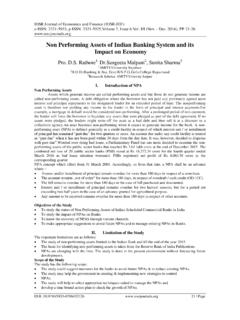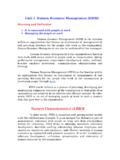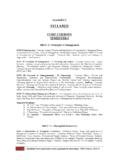Transcription of C.BMS.3.01 Human Resource Management - St. …
1 Human Resource Management Learning objectives To make students understand Human Resource in its proper perspective. To familiarize them with the various functions of Human Resource Management . To lay a strong foundation for pursuing goals of becoming HR strategists, change agents and organizational transformationalists. Sr. No Topics No. Of Lectures I Introduction to HRM Definition, features, scope/Functions of HRM. Evolution of HRM/ Trends in HRM Difference between HRM and PM Challenges Before the HR Manager Role of the HR manager Traits/Characteristics of the workforce, Personnel Philosophy Personnel Manual Human Resource Planning.
2 Definition of HRP Process of HRP along with brief coverage of personnel demand and supply Forecasting techniques Factors affecting HRP HRIS VRS, outsourcing, pinkslip/termination/retrenchment/downsi zing/ separation Contracting and sub-contracting Promotions and transfers 8 6 II Job analysis, Job Design and Job evaluation Job analysis- definition, method of collecting job data, merits and demerits/ limitations Job design definition, factors affecting job design , approaches to job design Job evaluation- definition, methods of job evaluation, process of job evaluation Recruitment, selection and Induction.
3 Recruitment- Definition, sources of recruitment , merits and demerits Selection- definition process of selection, types of selection tests, types of interviews Induction/orientation- definition, methods, process Placement Training and Development Definition if training and development Methods of training Managers Process/ Procedure of conducting training programs How to evaluate effectiveness of training program Advantages of T & D 5 5 6 III performance appraisal 7 Definition Methods of appraisal for managers traditional and modern Process/procedure of conducting performance appraisal Advantages of performance appraisal Limitations of performance appraisal Compensation Management Definition of compensation Components of salary/ salary slip Fringe
4 Benefits- definition and types performance linked incentives/incentives definition, advantages and disadvantages. Career planning and Development Definition of career planning and career development Process /procedure Career stages/career life cycle and how to handle personnel at each stage Essentials to make career planning successful Career counselling Employee Retention techniques Succession planning 6 6 IV Participative Management Definition of participative Management Levels of participation Trends in Participative Management Factors important for effective participative Management Forms of participation Participation through quality circles Empowered teams
5 Industrial relations Definition of industrial relations Features of industrial relations Importance of industrial relations Approaches to industrial relations Parties to industrial relations Trade Unions Definition of a trade union Features of a trade union Trade Union movement in India Trends in Trade Unions 4 4 3 Continuous Internal Assessment : Mid semester test Project Work-Presentation Reference Books Sr. No. Title Author Publisher 1 Human Resources and Personnel Management K Aswathappa Test and Cases, 4e 2 Personnel Management Mamoria 3 Personnel Management Flippo Mcgraw 4 Excellence through HRD M Nair and T V Rao 5 Handbook of Human Resource Armstrong and Management Practice Micheal Kogan Page Management Accounting Learning Objectives: To familiarize the students with the provisions and use of accounting information to managers within organizations.
6 To provide them with the basis to make informed business decisions that will allow them to be better equipped in their Management and control functions. To help them in preparing and presenting financial and other decision oriented information in such a way as to assist Management decision making. Unit Number Topics No. Of Lectures I Analysis and Interpretation of Accounts A. Study of Balance Sheet Schedule VI of Limited Company B. Study of Manufacturing Trading Profit and Loss Account of a Limited Company Vertical Forms: Relationship Between items in Balance Sheet and Profit and Loss account.
7 A. Trend analysis B. Comparative Statement C. Common Size Statement 20 Knowledge Understanding Application Unit I 06 05 Unit II 08 09 10 Unit III 04 03 04 Unit IV 04 03 04 TOTAL 22 20 18 II Ratio analysis and Interpretation ( Based on Vertical Form of Financial Accounts) including conventional and functional classification restricted to- a) Balance Sheet ration:- I. Current Ratio II. Liquid Ratio III. Stock Working capital ratio IV. Proprietary ratio V. Debt Equity ratio VI. Capital gearing ratio b) Revenue Statement Ratios: I. Gross Profit Ratio II. Expense Ratio III. Operating Ratio IV.
8 Net Profit Ratio V. Net operating profit Ratio VI. Stock turnover Ratio c) Combined ratios:- I. Return on Capital employed (including long term borrowings) II. Return on Proprietor s Funds ( Shareholders funds and preference share capital) III. Return on Equity capital, dividend payout ratio IV. Debt service Ratio V. Debtors Turnover VI. Creditors turnover Different modes of expressing Ratios :- rate, ratio, percentage, number Limitations of the use of rations, interaction of ratios 10 III Preparation of Statement of Sources and Application of Case (Cash flow statement) with reference to Accounting Standard No.
9 3 10 IV Working Capital concept Estimation/ projection of requirements in case of trading and Manufacturing Organization. Marginal costing Concept, Contribution, Break even analysis, Application if Marginal costing in Managerial Decision making Standard costing and Budgetary controls 20 Continuous Internal Assessment : Mid semester test Project Work-Assignment Reference Books: Sr. no. Title Author Publisher 1. Cost Management Saxena and Vashitha S. Chand and Sonsa 2. Cost & Management Accounting Ravi N. Kishore Pulication Taxmonth 3. Essentials of Management Accounting Reddy Himalaya 4.
10 Advanced Management Accounting Robert S. Kailer Prentice Hall 5. Financial of Management Accounting Varshney Wisdom 6. Introduction of Management Accounting Charbs T Hornram PHI Leavington 7. Management Accounting Vikas Publication 8. Cost and Management Accounting Mittal Galgotia 9. Management Accounting Khan and Jani Tata Mcgraw 10. Management Accounting Resstogi Gelgoha Production and Materials Management Learning Objectives: To help students understand the process of transformation of a range of inputs into the required products/services having the requisite quality level.







